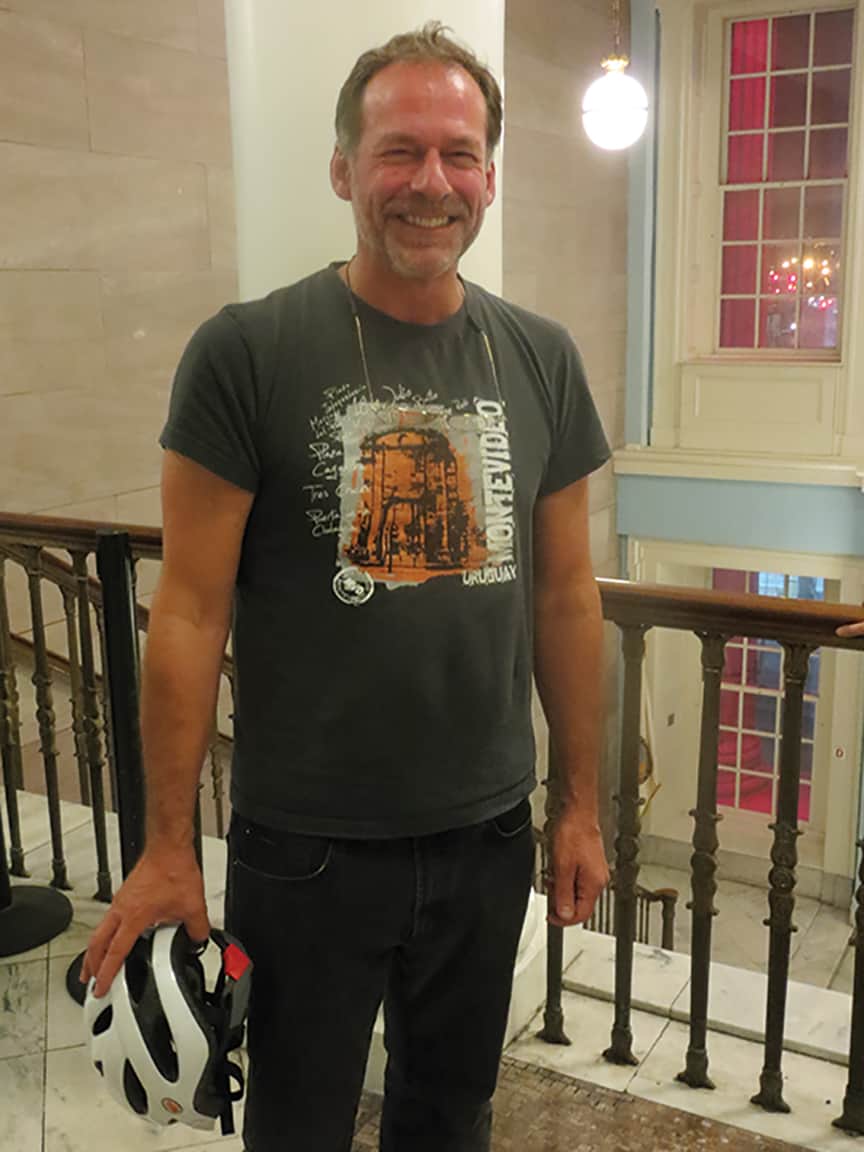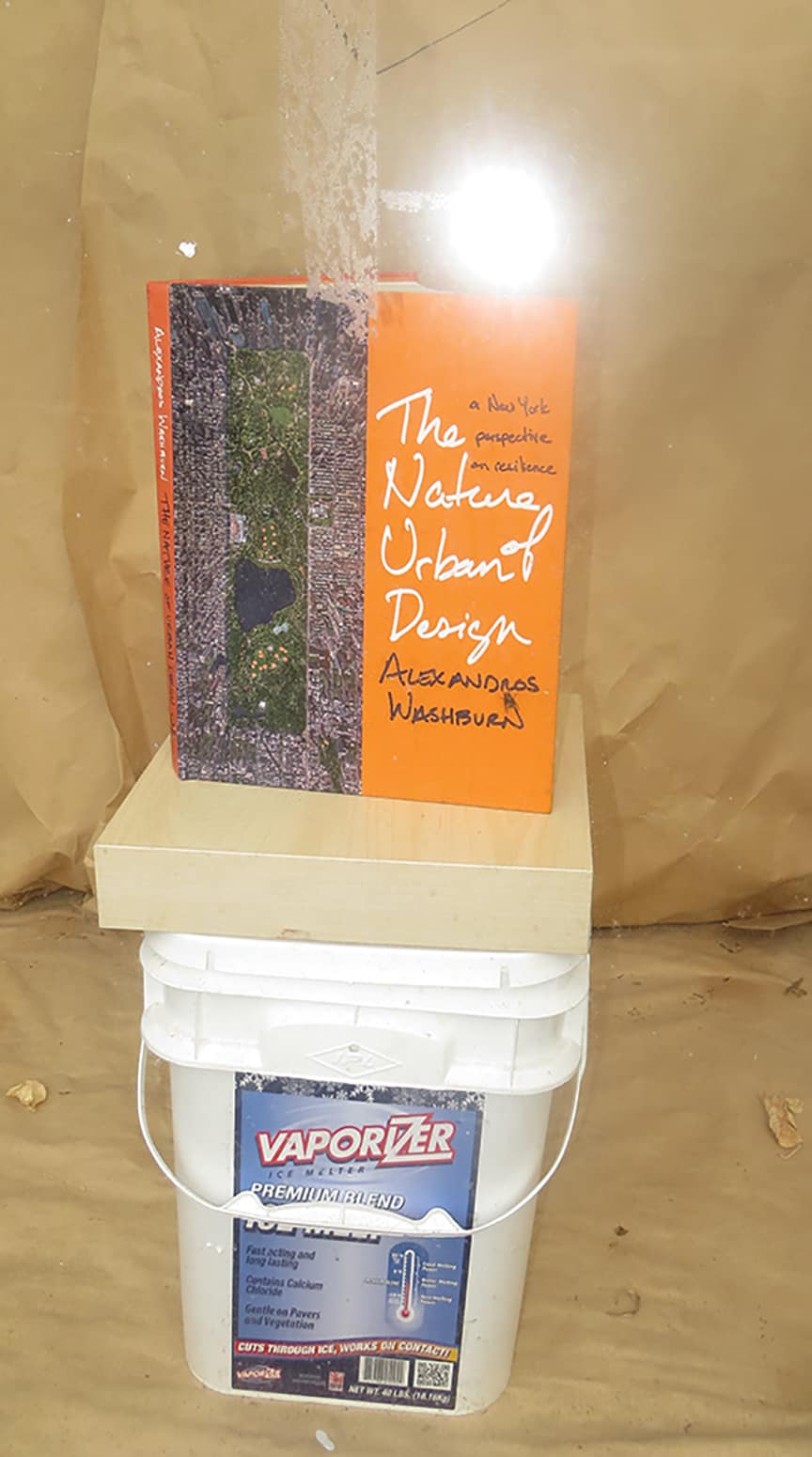When Sandy’s historic surge hit Red Hook three years ago, Alexandros Washburn stayed put in his Van Brunt Street row house. He didn’t stay because of blind pride or a delusion of safety. Rather, he stayed to learn.

As he watched the storm leak through his roof and flood his ground floor with three feet of filthy water, he took note of the structural dynamics of his building and the street outside. At the time, Washburn was the city’s chief urban designer under Mayor Bloomberg and had been studying “what if?” catastrophe scenarios for years. He currently works as an industry professor and Director of the Center for Coastal Resilience and Urban Xcellence (CRUX) at Stevens Institute of Technology. Of all people, he knew just how dangerous it was to stick around.
“If I wanted to understand the storm, there was no substitute for being there,” he said in an interview. “There is so much research on storm surges, but to be able to experience it, feel it, see it – that was beyond valuable for me not just from a science perspective, but from an emotional and social one.”
Ultimately, Sandy would teach Washburn about far more than sturdy windows and roof integrity. His education that day would inspire his countless lectures and projects, an acclaimed book about resilient urban design, flood monitoring technology, and plans for Red Hook that Washburn considers critical to its structural and cultural survival in the long term.
Moreover, he would learn that the storm response in New York is confusing, misguided, and broken – this coming from a man who spent much of his career in City Hall.
When we met at Fort Defiance for our interview, Washburn was eager to sit at the restaurant’s outdoor service window rather than indoors at the bar. That way, we could face the street and chat into the open air.
“The street needs to be embraced,” said the congenial Washburn over a Jacques & Doris cocktail. “Look how we’re sitting now. We’re part of the street. This is part of our domain. You have to encourage this. This type of set-up keeps the street safe.”
FEMA rules indicate that the only way to flood-proof a vulnerable residence and mitigate skyrocketing flood insurance premiums is to fill in the basement, abandon the first floor, elevate the home, or some mix of these pricey options.
Washburn studied the mandates carefully. He found that a homeowner’s only viable option is to create a storage space or a parking garage on the first floor. This, however, would destroy the coveted street culture of Red Hook, Washburn says.
“If we were all to follow what they wanted us to do, this neighborhood would be a parking lot,” Washburn said. “It would be horrible. Yes it would be flood-proof, but we have to define resilience at an appropriate scale, and the appropriate scale here is a community.”
Because he refused to go along with FEMA’s model, Washburn’s home remains in a somewhat limbo state. He hasn’t fully repaired his first floor since Sandy engulfed it. There are bare joists and walls. From the street, his Victorian storefront ground floor appears boarded up. Before Sandy, he had a tenant living there, but now it is unlivable. He and his wife and children now live in the stunning upper floors, which were designed by Washburn. The sun-drenched, high-ceilinged home was actually once featured in the New York Times real estate section.
As he watched his neighbors rebuild out of necessity and lend themselves to the mercy of insurance companies, Washburn remained one of the few holdouts.
“I have many sympathizers, but I don’t think I’m the norm here,” he said.
At one point Washburn even drew up an innovative, if not downright nutty flood-proofing plan: he could attach cables to his ceiling beams, which would crank up his floor panel – along with his computers, furniture, and more — out of a storm’s clutches. He has the architectural chops to make it happen, but the zoning laws won’t allow it.
Furthermore, navigating the insurance plans and zoning laws has been a veritable nightmare on nearly every level.
“I go around in circles trying to understand the city, state and federal regulations that should tell me how I can rebuild. They all conflict,” he wrote in his 2013 book, The Nature of Urban Design: A New York Perspective on Resilience. “I am amazed at the number of people I have to deal with.”
Washburn is no stranger to Red Hook planning controversy. The first time he set foot in the neighborhood in 2002, he was fighting against one of Red Hook’s most polarizing contenders: IKEA. He proposed a public fishing village of sorts as an alternative to the big box furniture store. He didn’t win that fight (“IKEA is a bird in the hand,” he was told by City Hall), but he did fall in love with the neighborhood and moved there permanently in 2007.
“I’m Greek on my mom’s side, so I take it as a given that everyone lives on the sea,” he said. “My first visit to Red Hook was the first time I’d felt that sensibility in New York. I’d lived in lower Manhattan for a long time near the water, but it wasn’t the same.”
Washburn also serves as urban strategies director for the architecture firm NBBJ, which designed the Red Hook Innovation District project: a massive 12-acre multi-use complex slated for development on the waterfront by Italian company Est4te Four. In this case, the new buildings will be basement-less, and will sit three feet higher than their original levels.
We can’t stop at the odd elevation and recovery measure, however. City Hall is aware that it needs build a more resilient, comprehensively protected neighborhood in the face of climate change. Otherwise, Red Hook risks social, financial, structural destruction every time a flood hits. A superstorm like Sandy may not be imminent, but the sea levels are rising each year. By the 2050s, some areas in New York should expect daily or weekly flooding.
“We are in the age of rising seas, and there has been no improvement at all yet,” Washburn said.
In 2013, the Bloomberg administration unveiled the Special Initiative for Rebuilding and Resiliency (SIRR) plan, a series of post-Sandy recommendations for flood-prone areas. In Red Hook, the recommendations include raised bulkheads along three miles of the waterfront, drainage improvements, and high-deductible insurance options from FEMA. The city is accepting proposals for construction and hopes to break ground in 2017. Red Hook was promised $200 million for the flood protection system.

Meanwhile, Washburn has been championing a protective perimeter around Red Hook, one that is far from shores and doesn’t impede views. Within these walls and polders, he envisions developing clean recreational water bodies over time. He recommends that buildings take notes from the 19th Century warehouses in Red Hook, which stand strong in the face of surges, and yet, they’re beautiful.
For the short term, Washburn started talks with the chemical juggernaut BASF in the hopes of developing sensor fabric technology. This fabric could act as a temporary perimeter and would buy Red Hook a few hours of surge protection while also monitoring the storm’s performance.
He’s also busy researching. Washburn’s coastal resilience program at Stevens Institute of Technology, CRUX, is getting scientific minds around the world invested in flooding problems that affect their cities. He even developed a technology – through NBBJ – that allows laymen to see a storm surge’s effect on their community in real time.
Through it all, he keeps Red Hook in mind.
“Red Hook is not alone. There are a billion people around the world within one meter above sea level,” he said. “I’ve got students in Singapore who think they’re working on Singapore problems, but they’re also working on Red Hook.”
In the end, he argues, change boils down to the residents.
“I think the Red Hook community has been very patient, which is a good thing,” he said. “But I think Red Hook has to be insistent. Because we can protect Red Hook and keep it beautiful. We can do it in a way that’s cost effective for the government but also improves our quality of life right here. We need to build a trust between the people who fear flooding, and the people whose job it is to propose a solution.”








